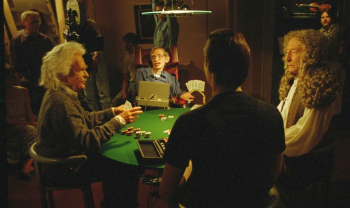Sean Carroll in The Atlantic:
 As a theoretical physicist who specializes in cosmology and gravitation, I naturally had many opportunities to interact with Stephen Hawking before his death. We attended the same physics conferences, where he was always rightfully celebrated as one of the world’s great scientists. He regularly visited the California Institute of Technology, where I work as a researcher. And, in perhaps my greatest contribution to world culture, I helped arrange Stephen’s cameo appearance on The Big Bang Theory.
As a theoretical physicist who specializes in cosmology and gravitation, I naturally had many opportunities to interact with Stephen Hawking before his death. We attended the same physics conferences, where he was always rightfully celebrated as one of the world’s great scientists. He regularly visited the California Institute of Technology, where I work as a researcher. And, in perhaps my greatest contribution to world culture, I helped arrange Stephen’s cameo appearance on The Big Bang Theory.
But to get a glimpse of what Stephen was really like, let me tell you the story of time I picked him up at the airport.
Usually picking someone up at the airport is not a major logistical operation. Stephen, who lived with amyotrophic lateral sclerosis, or ALS, traveled with a retinue of students and nurses, as well as his custom-made wheelchair and various pieces of medical equipment. But this should have made my job easier, rather than harder: All I was actually asked to do was to meet them upon their arrival and point them toward the special van that had been rented for Stephen’s use. In-and-out job, right?
I should have known better. First, only one person in Stephen’s group, a graduate assistant, was licensed to drive the van, and that assistant was staying in a different hotel than Stephen and the nurses. But Stephen had a rule that the van was to be with him at all times, even if the person who was allowed to drive the van was elsewhere. And he wanted to check into his own hotel room, then proceed to dinner, before the graduate assistant checked into the other hotel. So I was asked to follow the group as they went to the first hotel and then to dinner, at which point I could take the assistant to his hotel and then back to rejoin the group at the restaurant.
All was proceeding more or less according to plan, but after checking into the hotel it was decided that they really should stop for some grocery shopping before heading to dinner. While parked at a local supermarket, a stream of nurses traveled between the van and the store, bringing various samples of tea bags for Stephen to choose from. Stephen, solid Englishman that he was, was very particular about his tea. Eventually we were on our way to the restaurant. Following behind the van in my car, you could imagine my surprise when the van stopped dead in the middle of the road. It stayed that way for several minutes. This was in 1998, a time before everyone had cellphones, and I didn’t feel like getting out of the car in the midst of onrushing traffic, so I was stuck not understanding what was going on. Ultimately, the van started up again, performed a few turns, and ended up at the right place. Only later was it explained to me what had happened. Stephen was the only one who actually knew where the restaurant was. At some point while the graduate assistant was driving, a single word of Stephen’s synthesized voice came from the back of the van: “No!” Apparently they had gone too far. It always took Stephen a long time to compose sentences on his computer, but eventually he was able to guide the driver back on course. Long past midnight, hours after they had landed, I was finally able to head to my own bed.
Stephen Hawking, despite an overwhelming physical disability, did not put his fate into the hands of others. He was in control; he was The Decider. None of his extraordinary characteristics—intelligence, charisma, humor, courage—might have amounted to much, if it weren’t for his singular, stubborn insistence on living life on his own terms.
More here.
Around 41,000 years ago, a young woman died in a cold cave, high up in Siberia’s Altai Mountains. Scientists uncovered one of her pinky bones in 2008. From it, they extracted her DNA. And from that, they deduced that she belonged to a previously unknown group of ancient hominin, whom they called the Denisovans after the cave where the finger was found.
